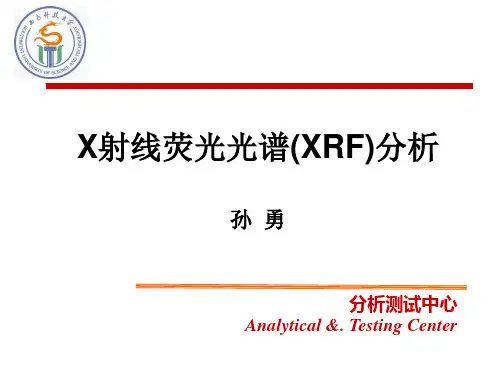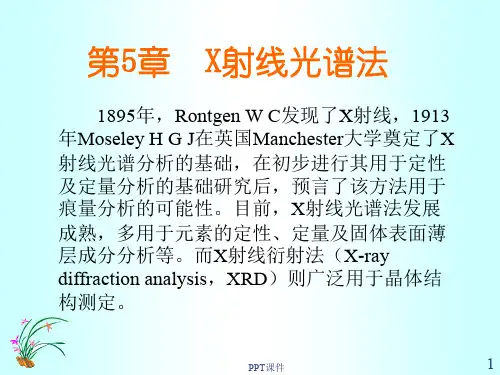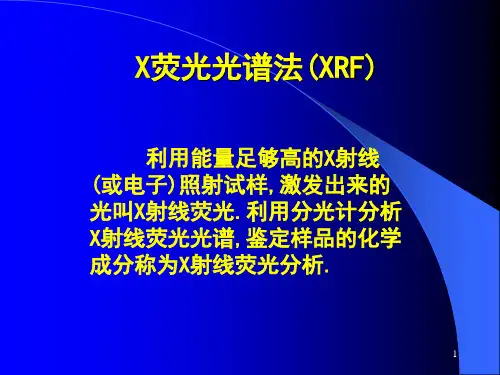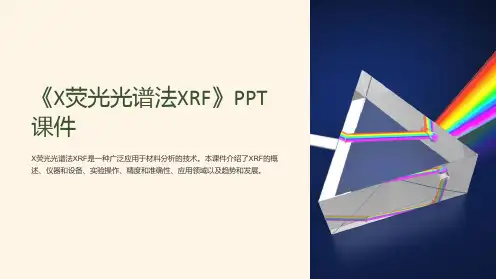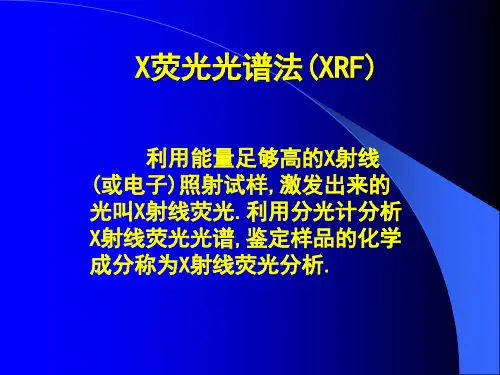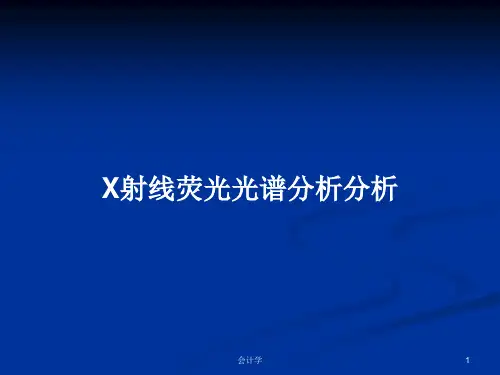X射线荧光光谱分析XRF_PPT课件
- 格式:ppt
- 大小:12.98 MB
- 文档页数:55
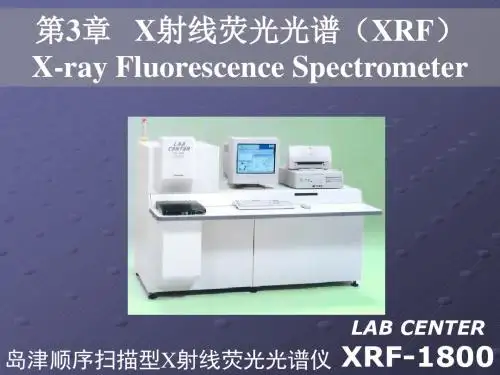
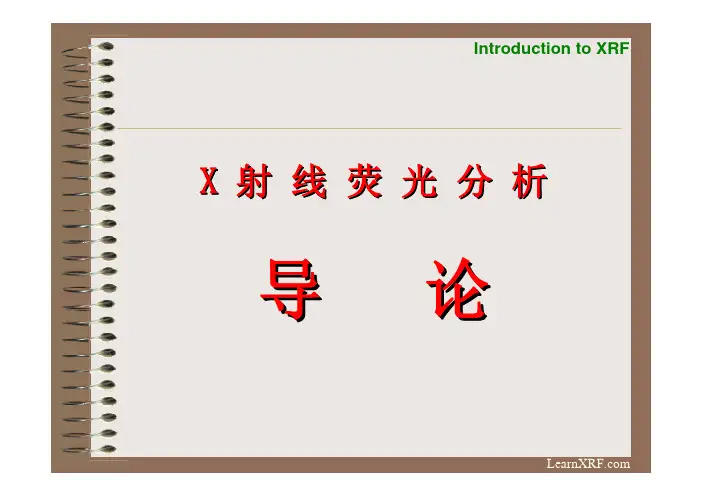
Introduction to XRFX 射 线 荧 光 分 析导论Introduction to XRF电子波谱1014Hz - 1015Hz 1Hz - 1kHz 超低频率 电磁波 无线电波 1kHz - 1014Hz 微波 1015Hz - 1021Hz红外线可见光紫外线 X射线伽马射线Low energyHigh energyIntroduction to XRFTheory入射X射线轰击原子的内层电子,如 果能量大于它的吸收边,该内层电子 被驱逐出整个原子(整个原子处于高 能态,即激发态)。
较高能级的电子跃迁、补充空穴,整 个原子处于低能态,即基态。
由高能态转化为低能态,释放能量。
ΔE=Eh-El .能量将以X射线的释放,产生X射线荧 光。
Introduction to XRFThe Hardware• • • • Sources Optics Filters & Targets DetectorsIntroduction to XRFSources•End Window X-Ray Tubes •Side Window X-Ray Tubes •Radioisotopes •Other Sources–Scanning Electron Microscopes –Synchrotrons –Positron and other particle beamsIntroduction to XRFEnd Window X-Ray Tube• X-ray Tubes– Voltage determines which elements can be excited. – More power = lower detection limits – Anode selection determines optimal source excitation (application specific).Introduction to XRFSide Window X-Ray TubeBe Window Glass EnvelopeTarget (Ti, Ag, Rh, etc.)HV LeadElectron beamCopper Anode FilamentSilicone InsulationIntroduction to XRFRadioisotopesIsotope Energy (keV) Elements (Klines) Elements (Llines) Fe-55 5.9 Al – V Br-I Cm-244 14.3, 18.3 Ti-Br I- Pb Cd-109 22, 88 Fe-Mo Yb-Pu Am-241 59.5 Ru-Er None Co-57 122 Ba - U noneWhile isotopes have fallen out of favor they are still useful for many gauging applications.Introduction to XRFOther SourcesSeveral other radiation sources are capable of exciting material to produce x-ray fluorescence suitable for material analysis.Scanning Electron Microscopes (SEM) – Electron beams excite the sample and produce x-rays. Many SEM’s are equipped with an EDX detector for performing elemental analysis Synchotrons - These bright light sources are suitable for research and very sophisticated XRF analysis. Positrons and other Particle Beams – All high energy particles beams ionize materials such that they give off x-rays. PIXE is the most common particle beam technique after SEM.Introduction to XRFSource ModifiersSeveral Devices are used to modify the shape or intensity of the source spectrum or the beam shape Source Filters Secondary Targets Polarizing Targets Collimators Focusing OpticsIntroduction to XRFSource FiltersFilters perform one of two functions–Background Reduction –Improved FluorescenceSource Filter Detector X-Ray SourceIntroduction to XRFFilter Transmission CurveTitanium Filter transmission curve% T R A N S M I T T E DAbsorption EdgeLow energy x-rays are absorbed Very high energy x-rays are transmittedX-rays above the absorption edge energy are absorbed ENERGYTiCrThe transmission curve shows the parts of the source spectrum are transmitted and those that are absorbedIntroduction to XRFFilter Fluorescence MethodWith Zn Source filter Target peakContinuum RadiationENERGY (keV)Fe RegionThe filter fluorescence method decreases the background and improves the fluorescence yield without requiring huge amounts of extra power.Introduction to XRFFilter Absorption MethodTarget peak With Ti Source filter Continuum RadiationENERGY (keV)Fe RegionThe filter absorption Method decreases the background while maintaining similar excitation efficiency.Introduction to XRFSecondary TargetsImproved Fluorescence and lower background The characteristic fluorescence of the custom line source is used to excite the sample, with the lowest possible background intensity. It requires almost 100x the flux of filter methods but gives superior results.Introduction to XRFSecondary TargetsSample Detector X-Ray Tube Secondary Target A. The x-ray tube excites the secondary target B. The Secondary target fluoresces and excites the sample C. The detector detects x-rays from the sampleIntroduction to XRFSecondary Target MethodWith Zn Secondary Target Tube Target peakContinuum RadiationENERGY (keV)Fe RegionSecondary Targets produce a more monochromatic source peak with lower background than with filtersIntroduction to XRFSecondary Target Vs FilterComparison of optimized direct-filtered excitation with secondary target excitation for minor elements in Ni-200Introduction to XRFPolarizing Target Theorya) X-ray are partially polarized whenever they scatter off a surface b) If the sample and polarizer are oriented perpendicular to each other and the x-ray tube is not perpendicular to the target, x-rays from the tube will not reach the detector. c) There are three type of Polarization Targets:– – Barkla Scattering Targets - They scatter all source energies to reduce background at the detector. Secondary Targets - They fluoresce while scattering the source x-rays and perform similarly to other secondary targets. Diffractive Targets - They are designed to scatter specific energies more efficiently in order to produce a stronger peak at that energy.–Introduction to XRFCollimatorsCollimators are usually circular or a slit and restrict the size or shape of the source beam for exciting small areas in either EDXRF or uXRF instruments. They may rely on internal Bragg reflection for improved efficiency.SampleTubeCollimator sizes range from 12 microns to several mmIntroduction to XRFFocusing OpticsBecause simple collimation blocks unwanted x-rays it is a highly inefficient method. Focusing optics like polycapillary devices and other Kumakhov lens devices were developed so that the beam could be redirected and focused on a small spot. Less than 75 um spot sizes are regularly achieved.Bragg reflection inside a CapillarySourceDetectorIntroduction to XRFDetectors• Si(Li) • PIN Diode • Silicon Drift Detectors • Proportional Counters • Scintillation DetectorsIntroduction to XRFDetector PrinciplesA detector is composed of a non-conducting or semi-conducting material between two charged electrodes. X-ray radiation ionizes the detector material causing it to become conductive, momentarily. The newly freed electrons are accelerated toward the detector anode to produce an output pulse. In ionized semiconductor produces electron-hole pairs, the number of pairs produced is proportional to the X-ray photon energyn = E ew h e re :n E e= n u m b e r o f e le c tro n -h o le p a irs p ro d u c e d = X -ra y p h o to n e n e rg y = 3 .8 e v fo r S i a t L N 2 te m p e r a tu re sIntroduction to XRFSi(Li) DetectorWindow FETSuper-Cooled CryostatSi(Li) crystalPre-AmplifierDewar filled with LN2Cooling: LN2 or Peltier Window: Beryllium or Polymer Counts Rates: 3,000 – 50,000 cps Resolution: 120-170 eV at Mn K-alphaIntroduction to XRFSi(Li) Cross SectionIntroduction to XRFPIN Diode DetectorCooling: Thermoelectrically cooled (Peltier) Window: Beryllium Count Rates: 3,000 – 20,000 cps Resolution: 170-240 eV at Mn k-alphaIntroduction to XRFSilicon Drift Detector- SDDPackaging: Similar to PIN Detector Cooling: Peltier Count Rates; 10,000 – 300,000 cps Resolution: 140-180 eV at Mn K-alphaIntroduction to XRFProportional CounterWindowAnode FilamentFill Gases: Neon, Argon, Xenon, Krypton Pressure: 0.5- 2 ATM Windows: Be or Polymer Sealed or Gas Flow Versions Count Rates EDX: 10,000-40,000 cps WDX: 1,000,000+ Resolution: 500-1000+ eVIntroduction to XRFScintillation DetectorPMT (Photo-multiplier tube) Sodium Iodide Disk ElectronicsWindow: Be or Al Count Rates: 10,000 to 1,000,000+ cps Resolution: >1000 eVConnectorIntroduction to XRFSpectral Comparison - AuSi(Li) Detector 10 vs. 14 KaratSi PIN Diode Detector 10 vs. 14 KaratIntroduction to XRFPolymer Detector Windows♦ Optional thin polymer windows compared to a standard beryllium windows ♦ Affords 10x improvement in the MDL for sodium (Na)Introduction to XRFDetector FiltersFilters are positioned between the sample and detector in some EDXRF and NDXRF systems to filter out unwanted x-ray peaks. Sample Detector Filter Detector X-Ray SourceIntroduction to XRFDetector Filter TransmissionNiobium Filter Transmission and Absorption% T R A N S M I T T E DEOI is transmittedLow energy x-rays are absorbedAbsorption EdgeVery high energy x-rays are transmittedX-rays above the absorption edge energy are absorbed ENERGYSClA niobium filter absorbs Cl and other higher energy source x-rays while letting S x-rays pass. A detector filter can significantly improve detection limits.Introduction to XRFFilter Vs. No FilterDetector filters can dramatically improve the element of interest intensity, while decreasing the background, but requires 4-10 times more source flux. They are best used with large area detectors that normally do not require much power.Unfiltered Tube target, Cl, and Ar Interference PeakIntroduction to XRFRoss Vs. Hull FiltersThe previous slide was an example of the Hull or simple filter method. The Ross method illustrated here for Cl analysis uses intensities through two filters, one transmitting, one absorbing, and the difference is correlated to concentration. This is an NDXRF method since detector resolution is not important.Introduction to XRFWavelength Dispersive XRFWavelength Dispersive XRF relies on a diffractive device such as crystal or multilayer to isolate a peak, since the diffracted wavelength is much more intense than other wavelengths that scatter of the device.Sample DetectorCollimatorsX-Ray SourceDiffraction DeviceIntroduction to XRFDiffractionThe two most common diffraction devices used in WDX instruments are the crystal and multilayer. Both work according to the following formula.nλ = 2d × sinθn = integer d = crystal lattice or multilayer spacing θ = The incident angle λ = wavelengthAtomsIntroduction to XRFMultilayersWhile the crystal spacing is based on the natural atomic spacing at a given orientation the multilayer uses a series of thin film layers of dissimilar elements to do the same thing. Modern multilayers are more efficient than crystals and can be optimized for specific elements. Often used for low Z elements.Introduction to XRFSoller CollimatorsSoller and similar types of collimators are used to prevent beam divergence. The are used in WDXRF to restrict the angles that are allowed to strike the diffraction device, thus improving the effective resolution.SampleCrystalIntroduction to XRFCooling and Temperature ControlMany WDXRF Instruments use:•X-Ray Tube Coolers, and •Thermostatically controlled instrument coolersThe diffraction technique is relatively inefficient and WDX detectors can operate at much higher count rates, so WDX Instruments are typically operated at much higher power than direct excitation EDXRF systems. Diffraction devices are also temperature sensitive.Introduction to XRFChamber AtmosphereSample and hardware chambers of any XRF instrument may be filled with air, but because air absorbs low energy x-rays from elements particularly below Ca, Z=20, and Argon sometimes interferes with measurements purges are often used. The two most common purge methods are:Vacuum - For use with solids or pressed pellets Helium - For use with liquids or powdered materialsIntroduction to XRFChangers and SpinnersOther commonly available sample handling features are sample changers or spinners.Automatic sample changers are usually of the circular or XYZ stage variety and may have hold 6 to 100+ samples Sample Spinners are used to average out surface features and particle size affects possibly over a larger total surface area.Introduction to XRFTypical PIN Detector InstrumentThis configuration is most commonly used in higher end benchtop EDXRF Instruments.Introduction to XRFTypical Si(Li) Detector InstrumentThis has been historically the most common laboratory grade EDXRF configuration.Introduction to XRFEnergy Dispersive ElectronicsFluorescence generates a current in the detector. In a detector intended for energy dispersive XRF, the height of the pulse produced is proportional to the energy of the respective incoming X-ray.Element A Element B Element C Element DSignal to ElectronicsDETECTORIntroduction to XRFMulti-Channel Analyser• • Detector current pulses are translated into counts (counts per second, “CPS”). Pulses are segregated into channels according to energy via the MCA (Multi-Channel Analyser).Intensity (# of CPS per Channel)Signal from DetectorChannels, EnergyIntroduction to XRFWDXRF Pulse ProcessingThe WDX method uses the diffraction device and collimators to obtain good resolution, so The detector does not need to be capable of energy discrimination. This simplifies the pulse processing. It also means that spectral processing is simplified since intensity subtraction is fundamentally an exercise in background subtraction.Note: Some energy discrimination is useful since it allows for rejection of lowenergy noise and pulses from unwanted higher energy x-rays.Introduction to XRFEvaluating SpectraIn addition to elemental peaks, other peaks appear in the spectra:• • • • • •K & L Spectral Peaks Rayleigh Scatter Peaks Compton Scatter Peaks Escape Peaks Sum Peaks BremstrahlungIntroduction to XRFK & L Spectral LinesL beta L alphaK - alpha lines: L shell etransition to fill vacancy in K shell. Most frequent transition, hence most intense peak.K betaK alphaK - beta lines: M shell etransitions to fill vacancy in K shell.K Shell L Shell M Shell N ShellL - alpha lines: M shell etransition to fill vacancy in L shell.L - beta lines: N shell etransition to fill vacancy in L shell.Introduction to XRFK & L Spectral PeaksK-Lines L-linesRh X-ray Tube。
